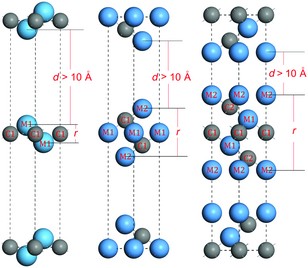Crossref Citations
This article has been cited by the following publications. This list is generated based on data provided by
Crossref.
Naguib, Michael
Halim, Joseph
Lu, Jun
Cook, Kevin M.
Hultman, Lars
Gogotsi, Yury
and
Barsoum, Michel W.
2013.
New Two-Dimensional Niobium and Vanadium Carbides as Promising Materials for Li-Ion Batteries.
Journal of the American Chemical Society,
Vol. 135,
Issue. 43,
p.
15966.
Hu, Qianku
Sun, Dandan
Wu, Qinghua
Wang, Haiyan
Wang, Libo
Liu, Baozhong
Zhou, Aiguo
and
He, Julong
2013.
MXene: A New Family of Promising Hydrogen Storage Medium.
The Journal of Physical Chemistry A,
Vol. 117,
Issue. 51,
p.
14253.
Ivanovskii, A L
and
Enyashin, A N
2013.
Graphene-like transition-metal nanocarbides and nanonitrides.
Russian Chemical Reviews,
Vol. 82,
Issue. 8,
p.
735.
Xie, Yu
and
Kent, P. R. C.
2013.
Hybrid density functional study of structural and electronic properties of functionalized Tin+1Xn(X=C, N) monolayers.
Physical Review B,
Vol. 87,
Issue. 23,
Mashtalir, Olha
Naguib, Michael
Mochalin, Vadym N.
Dall’Agnese, Yohan
Heon, Min
Barsoum, Michel W.
and
Gogotsi, Yury
2013.
Intercalation and delamination of layered carbides and carbonitrides.
Nature Communications,
Vol. 4,
Issue. 1,
Lane, Nina J.
Barsoum, Michel W.
and
Rondinelli, James M.
2013.
Correlation effects and spin-orbit interactions in two-dimensional hexagonal 5d transition metal carbides, Ta
n+1
C
n
(n = 1,2,3)
.
EPL (Europhysics Letters),
Vol. 101,
Issue. 5,
p.
57004.
Lukatskaya, Maria R.
Mashtalir, Olha
Ren, Chang E.
Dall’Agnese, Yohan
Rozier, Patrick
Taberna, Pierre Louis
Naguib, Michael
Simon, Patrice
Barsoum, Michel W.
and
Gogotsi, Yury
2013.
Cation Intercalation and High Volumetric Capacitance of Two-Dimensional Titanium Carbide.
Science,
Vol. 341,
Issue. 6153,
p.
1502.
Khazaei, Mohammad
Arai, Masao
Sasaki, Taizo
Estili, Mehdi
and
Sakka, Yoshio
2014.
Two-dimensional molybdenum carbides: potential thermoelectric materials of the MXene family.
Phys. Chem. Chem. Phys.,
Vol. 16,
Issue. 17,
p.
7841.
Ling, Zheng
Ren, Chang E.
Zhao, Meng-Qiang
Yang, Jian
Giammarco, James M.
Qiu, Jieshan
Barsoum, Michel W.
and
Gogotsi, Yury
2014.
Flexible and conductive MXene films and nanocomposites with high capacitance.
Proceedings of the National Academy of Sciences,
Vol. 111,
Issue. 47,
p.
16676.
Er, Dequan
Li, Junwen
Naguib, Michael
Gogotsi, Yury
and
Shenoy, Vivek B.
2014.
Ti3C2 MXene as a High Capacity Electrode Material for Metal (Li, Na, K, Ca) Ion Batteries.
ACS Applied Materials & Interfaces,
Vol. 6,
Issue. 14,
p.
11173.
Hu, Qianku
Wang, Haiyan
Wu, Qinghua
Ye, Xiaotao
Zhou, Aiguo
Sun, Dandan
Wang, Libo
Liu, Baozhong
and
He, Julong
2014.
Two-dimensional Sc2C: A reversible and high-capacity hydrogen storage material predicted by first-principles calculations.
International Journal of Hydrogen Energy,
Vol. 39,
Issue. 20,
p.
10606.
Hu, Junping
Xu, Bo
Ouyang, Chuying
Yang, Shengyuan A.
and
Yao, Yugui
2014.
Investigations on V2C and V2CX2 (X = F, OH) Monolayer as a Promising Anode Material for Li Ion Batteries from First-Principles Calculations.
The Journal of Physical Chemistry C,
Vol. 118,
Issue. 42,
p.
24274.
Naguib, Michael
Mochalin, Vadym N.
Barsoum, Michel W.
and
Gogotsi, Yury
2014.
25th Anniversary Article: MXenes: A New Family of Two‐Dimensional Materials.
Advanced Materials,
Vol. 26,
Issue. 7,
p.
992.
Wang, Shun
Li, Jing-Xiao
Du, Yu-Lei
and
Cui, Chong
2014.
First-principles study on structural, electronic and elastic properties of graphene-like hexagonal Ti2C monolayer.
Computational Materials Science,
Vol. 83,
Issue. ,
p.
290.
Zhao, Shijun
Kang, Wei
and
Xue, Jianming
2014.
Role of Strain and Concentration on the Li Adsorption and Diffusion Properties on Ti2C Layer.
The Journal of Physical Chemistry C,
Vol. 118,
Issue. 27,
p.
14983.
Zhao, Shijun
Kang, Wei
and
Xue, Jianming
2014.
Manipulation of electronic and magnetic properties of M2C (M = Hf, Nb, Sc, Ta, Ti, V, Zr) monolayer by applying mechanical strains.
Applied Physics Letters,
Vol. 104,
Issue. 13,
Khazaei, Mohammad
Arai, Masao
Sasaki, Taizo
Estili, Mehdi
and
Sakka, Yoshio
2014.
The effect of the interlayer element on the exfoliation of layered Mo2AC (A = Al, Si, P, Ga, Ge, As or In) MAX phases into two-dimensional Mo2C nanosheets.
Science and Technology of Advanced Materials,
Vol. 15,
Issue. 1,
p.
014208.
Eames, Christopher
and
Islam, M. Saiful
2014.
Ion Intercalation into Two-Dimensional Transition-Metal Carbides: Global Screening for New High-Capacity Battery Materials.
Journal of the American Chemical Society,
Vol. 136,
Issue. 46,
p.
16270.
Yang, Eunjeong
Ji, Hyunjun
Kim, Jaehoon
Kim, Heejin
and
Jung, Yousung
2015.
Exploring the possibilities of two-dimensional transition metal carbides as anode materials for sodium batteries.
Physical Chemistry Chemical Physics,
Vol. 17,
Issue. 7,
p.
5000.
Guo, Zhonglu
Zhu, Linggang
Zhou, Jian
and
Sun, Zhimei
2015.
Microscopic origin of MXenes derived from layered MAX phases.
RSC Advances,
Vol. 5,
Issue. 32,
p.
25403.





